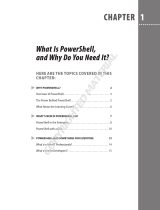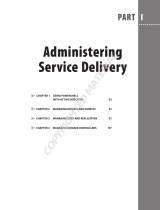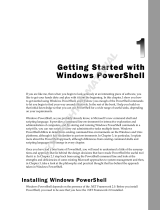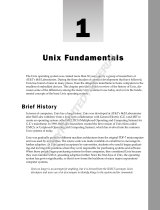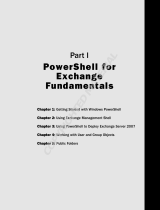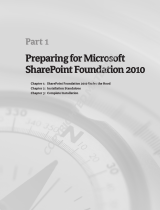Page is loading ...

What Is Windows
PowerShell?
Windows PowerShell is the extensible command-line interface shell and scripting language that
provides a command-line environment for interactive exploration and administration of computers.
In addition, it provides developers with an opportunity to script these commands, enabling them
to be automated, scheduled, and run multiple times.
This chapter covers the following topics:
❑ A brief overview of command-line interfaces
❑ Prerequisites for installing PowerShell
❑ Installing PowerShell 2.0 CTP3.
Command-Line Interfaces versus Graphical
User Interfaces
Before UNIX, Linux, and Windows surfaced in the information technology market, input media
such as punched card and punched tape were used. All the input and instructions to the computer
used command lines.
When UNIX and Linux were released, administrators started managing the operating system using
command-line interfaces, which were also used by the day-to-day users and programmers to inter-
act with the operating system.
UNIX and Linux are built on command-line interfaces, so there has always been administrative
scripting and different shells, such as the Korn shell, the C shell, and the Bourne shell. Programming
languages such as TCL and PERL were immediately available.
COPYRIGHTED MATERIAL

Chapter 1: What Is Windows PowerShell?
Originally, when Microsoft released MS-DOS, it was not used as a shell. It was entirely a standalone
operating system. The initial and original Microsoft Windows release was a graphical shell that sat on
top of the MS-DOS operating system. Once Windows NT was introduced, this situation was reversed.
MS-DOS became the shell in the graphical Windows operating system.
Graphical user interfaces (GUIs) were basically developed for users with less technical background who
were looking for a friendly interface. Because graphical interfaces are limited to fewer functions, once
you hit their limitations you will start relying on the command-line interface. For example, with a GUI,
if you want to rename all the extensions of a group of files and suffix each file with the current day’s
timestamp, it will take a while because you have to select and rename each file individually.
Therefore, command-line interfaces and their commands are very commonly used for administrative
tasks and automation. They also help to consolidate functionality in batches, through MS-DOS batch
files.
command.com
was used as the command-line user interface in early versions of Microsoft Windows.
cmd.exe
was introduced in Windows NT.
When administrators reached the limit of command-line batch files, they started looking for a language
that could do both command shell functions and programming. Microsoft introduced the Visual Basic
scripting language, which helped administrators initially. However, there were limitations in VBScript as
well. Administrators started relying on Windows Management Instrumentation (WMI) and COM objects
introduced later by Microsoft for many other administrative functions.
The administrative command-line interface started becoming more complicated with internal DOS com-
mands, external DOS commands, batch files, executables, VBScripts, WMI, and so forth.
It was with all of this in mind that Microsoft developed and introduced Windows PowerShell.
Prerequisites for Installing Windows
PowerShell 2.0
Windows PowerShell can be installed and run on Windows XP, Windows Vista, Windows Server 2003,
and Windows Server 2008. Although Windows PowerShell is included as part of Windows Server 2008,
it is not installed by default on Windows XP, Windows 2003, or Windows Vista. At the time of writing,
Windows PowerShell 1.0 is visible as a feature in Windows Server 2008 that can be turned on.
Windows PowerShell 1.0 is also installed with Exchange Server 2007, System Center Operations Manager
2007, System Center Data Protection Manager V2, and System Center Virtual Machine Manager because
they leverage Windows PowerShell to improve administrator control, efficiency, and productivity.
This book uses Windows PowerShell 2.0 CTP3. Before installing Windows PowerShell 2.0 CTP3, you
should ensure that your system has the following software programs it requires:
❑ Windows XP Service Pack 3, Windows 2003 Service Pack 2, Windows Vista Service Pack 1, or
Windows Server 2008
❑ Microsoft .NET Framework 2.0 or greater
2

Chapter 1: What Is Windows PowerShell?
❑ Windows Remote Management 2.0 CTP3 for Windows PowerShell remoting and background
jobs
❑ Microsoft .NET Framework 3.5 Service Pack 1 for Windows PowerShell Integrated Scripting
Environment (ISE) and the Out-GridView cmdlet
If .NET Framework 2.0 is not installed on your computer, the error message shown in Figure 1-1 will pop
up when you try to install Windows PowerShell 2.0 CTP3.
Figure 1-1
After installing the .NET Framework, if you continue to install on a non-standard operating system such
as Windows Server 2000, Windows NT, and so on, you may get the error shown in Figure 1-2.
Figure 1-2
Although Figure 1-2 shows v1.0 in the title bar and file path, it is actually PowerShell 2.0 CTP3. Com-
munity Technology Preview, also known as CTP3, is basically the bug fix that Microsoft relies on, adding
new features based on feedback from the technology community. The folder may be changed to v2.0 once
the release to manufacturing (RTM) version is released.
In order to check the prerequisites for the PowerShell installation, we created a batch file to run all the
necessary checks. Listing 1-1 shows the MS-DOS batch script,
CheckPowershellPreqs.bat
,whichuses
Windows Management Instrumentation Command-line (WMIC) to check the requirements before you
install Windows PowerShell. WMIC enables you to access WMI information via the command line. In
some respects, you can think of WMIC as an early prototype of PowerShell. However, WMIC can only
output its results as text. It doesn’t return programming objects that can be further processed, as Window
PowerShell does, and as you will see later.
Listing 1-1: CheckPowershellPreqs.bat
@ECHO Off
REM *****************************************************************
REM *Objective: TO check if the current windows version is *
REM * Compatible for PowerShell 2.0 and its pre-requisites*
REM *Created by: Yan and MAK *
REM *Created Date: 2008/09/01 *
Continued
3

Chapter 1: What Is Windows PowerShell?
Listing 1-1: CheckPowershellPreqs.bat (continued)
REM * *
REM *****************************************************************
SET OS_VERSION
=
SET Service_Pack
=
REM Find OS version
FOR /F "delims
==
tokens
=
2" %%i IN (’wmic os get Version /value’)
DO SET OS_VERSION
=
%%i
IF NOT DEFINED OS_VERSION (
ECHO WMIC is not installed on this system.
GOTO :END_SCRIPT
)
REM Find service pack value
FOR /F "delims
==
tokens
=
2" %%i IN (’wmic os get ServicePackMajorVersion /value’)
DO SET Service_Pack
=
%%i
REM Windows XP
IF "%OS_VERSION%"
==
"5.1.2600" (
@IF "%Service_Pack%" LSS "3" (
ECHO %OS_NAME% Service Pack 3 is required
GOTO :END_SCRIPT
)
GOTO :DOTNETFRAMEWORK_CHECK
)
REM Windows Server 2003
IF "%OS_VERSION%"
==
"5.2.3790" (
@IF "%Service_Pack%" LSS "2" (
ECHO %OS_NAME% Service Pack 2 is required
GOTO :END_SCRIPT
)
GOTO :DOTNETFRAMEWORK_CHECK
)
REM Windows Vista
IF "%OS_VERSION%"
==
"6.0.6001" (
@IF "%Service_Pack%" LSS "1" (
ECHO %OS_NAME% Service Pack 1 is required
GOTO :END_SCRIPT
)
GOTO :DOTNETFRAMEWORK_CHECK
)
IF "%OS_VERSION%" GTR "5.2.3790" (
GOTO :DOTNETFRAMEWORK_CHECK
)
ELSE (
GOTO :END_SCRIPT
)
4

Chapter 1: What Is Windows PowerShell?
Listing 1-1: CheckPowershellPreqs.bat (continued)
REM Check .NET framework
:DOTNETFRAMEWORK_CHECK
wmic product where (caption like "Microsoft .NET Framework%%") get Version /value |
findstr "
=
[2-9]\.*" > nul
IF "%ERRORLEVEL%"
==
"1" (
ECHO .NET Framework 2.0 or greater is required
GOTO :END_SCRIPT
)
REM Check Windows remote management
:WINRMCHECK
wmic path Win32_service where caption
=
"Windows Remote Management (WS-Management)" |
findstr /i "(WS-Management)" > nul
IF "%ERRORLEVEL%"
==
1(
ECHO Windows Remote Management is required
GOTO :END_SCRIPT
)
ECHO Your system meets the requirements
:END_SCRIPT
From a Windows command console, run
CheckPowershellPreqs.bat
from the script directory
C:\DBAScripts
. You should get a message similar to the one shown in Figure 1-3 if your system meets
the requirements for a PowerShell installation.
Figure 1-3
You may run into an error as follows on Windows Server 2003:
ERROR:
Code
=
0x80041010
Description
=
Invalid class
Facility
=
WMI
This means that you need to install the WMI Windows Installer Provider in order for WMIC to work.
To do so, open Control Panel Add/Remove Programs. Select Add/Remove Windows Components.
Double-click Management and Monitoring Tools. Select WMI Windows Installer Provider, and then click
OK to install.
If your operating system is Windows XP Service Pack 2 and you install Windows PowerShell 2.0 CTP3, it
may or may not work. The officially supported service pack for Windows XP when installing Windows
5

Chapter 1: What Is Windows PowerShell?
PowerShell 2.0 CPT3 is Service Pack 3, so when executing
C:\DBAScripts\CheckPowershellPreqs.bat
it will complain that Service Pack 3 is required.
Installing the Microsoft .NET Framework
Windows PowerShell integrates with the .NET Framework and provides a shell environment to per-
form administrative tasks. PowerShell exposes the .NET classes as built-in commands, and when these
commands are executed they produce one or more structured objects as output.
Download the .NET Framework from
http://download.microsoft.com
and install .NET Framework 2
or later. It is recommended that you use .NET 3.5, although all the code in this book works on .NET
Framework 2 and later. In Chapter 11, you will see that an SQL Server 2008 installation installs .NET 3.5
by default.
Installing Windows Remote Management
Another prerequisite is to install Windows Remote Management (WinRM). WinRM is required for Win-
dows PowerShell remoting and background jobs. You can download WinRM 2.0 CTP3 (also known as
Ws-Management) from
https://connect.microsoft.com/WSMAN/Downloads
for Windows Vista and
Windows Server 2008. The installation procedures of the executable
Windows6.0-KB950099-x86.msu
for
32-bit and
Windows6.0-KB950099-x64.msu
for 64-bit are shown in Figure 1-4 and Figure 1-5.
Figure 1-4
Figure 1-5
6

Chapter 1: What Is Windows PowerShell?
Double-click on
Windows6.0-KB950099-x86.msu
if you are installing WinRM on a 32-bit Windows oper-
ating system. Double-click on
Windows6.0-KB950099-x64.msu
if you are installing it on a 64-bit Windows
operating system.
If you already have Windows PowerShell 1.0 installed on your machine, then you have to uninstall
PowerShell 1.0 first and then install PowerShell 2.0 CTP3.
To uninstall Windows PowerShell 1.0, follow these steps:
1. Click Start ➪ Run, type appwiz.cpl, and then click OK.
2. Select the Show Updates check box (on the top in the middle).
3. In the list of currently installed programs, click Windows PowerShell(TM) 1.0, and then click
Remove. If you don’t see Windows PowerShell(TM) 1.0, please look for Windows Hotfix
926139, 926140, or 926141.
4. Follow the instructions to remove Windows PowerShell(TM) 1.0.
If you already have Windows PowerShell 2.0 CTP1 or CTP2, you have to uninstall them also. They
appear as ‘‘Windows PowerShell V2 (TM)’’ in the program list.
In Windows 2008, Windows PowerShell 1.0 is made visible as a Windows feature. You can disable and
uninstall the
PowerShell
feature as described here:
1. Click Start at the Windows taskbar.
2. Click Server Manager Features Add Feature, and uncheck the Windows PowerShell
check box.
3. Click Next to uninstall.
Now that you have the acceptable operating system, the .NET Framework, and Windows Remote Man-
agement, the next section provides the steps needed to actually install Windows PowerShell 2.0 CTP3.
Installing Windows PowerShell
To install Windows PowerShell on Windows XP or Windows 2003 systems, do the following:
1. Download the Windows PowerShell 2.0 CTP3 installation file from
www.Microsoft.com/
downloads
. The name of the installation file varies according to platform, operating system,
and language pack. Choose the appropriate version for your operating system. If you have a
64-bit Windows operating system, then please download
PowerShell_Setup_amd64.msi
,as
shown in Figure 1-6. If you have a 32-bit Windows operating system, then please download
PowerShell_Setup_x86.msi
, as shown in Figure 1-7.
2. After downloading the appropriate version for your operating system, you will see the ini-
tial screen of the installation wizard, similar to the one shown in Figure 1-8. Click Next.
3. Accept the license agreement, as shown in Figure 1-9, and click Next.
7

Chapter 1: What Is Windows PowerShell?
Figure 1-6
Figure 1-7
Figure 1-8
8

Chapter 1: What Is Windows PowerShell?
Figure 1-9
4. It takes a few minutes to complete the install. As shown in Figure 1-10, click Install to begin
the installation process. You will see the progress of the installation, as shown in Figure 1-11.
Figure 1-10
5. When installation is completed successfully, you will see a screen similar to the one shown
in Figure 1-12. Click Finish.
On 32-bit versions of Windows, Windows PowerShell is installed by default in the
%SystemRoot%
\System32\WindowsPowerShell\v1.0
directory.
On 64-bit versions of Windows, a 32-bit version of Windows PowerShell is installed in the
%SystemRoot%\SystemWow64\WindowsPowerShell\v1.0
directory and a 64-bit version of Windows
PowerShell is installed in the
%SystemRoot%\System32\WindowsPowerShell\v1.0
directory.
9

Chapter 1: What Is Windows PowerShell?
Figure 1-11
Figure 1-12
This book covers Windows PowerShell 2.0 CTP3. The installation file replaces the executables in the v1.0
folder. The actual folders for Windows PowerShell may change to v2.0 when PowerShell 2.0 RTM is
released.
Launching Windows PowerShell
Windows PowerShell can be launched in several ways. This section describes the different methods. No
method is superior to the others. It is just a matter of preference.
10

Chapter 1: What Is Windows PowerShell?
Using the Command console
To launch Windows PowerShell using the command console, open the command console and then type
powershell, as shown in Figure 1-13.
Figure 1-13
Using All Programs
You can also click Start All Programs Windows PowerShell V2 (CTP3), and then select and click
Windows PowerShell V2 (CTP3), as shown in Figure 1-14.
Figure 1-14
You may also see Windows PowerShell ISE (CTP3) in the Windows Program menu. The Windows Power-
Shell Integrated Scripting Environment (ISE) is a host application for Windows PowerShell. In Windows
PowerShell ISE, you can run commands and write, test, and debug scripts in a single Windows graph-
ical user interface. This book illustrates all Windows PowerShell-related cmdlets and scripts using a
command-line interface. It does not illustrate PowerShell scripts using the ISE.
Once PowerShell is launched, you can see the command prompt. The prompt in the PowerShell com-
mand window varies according to the operating system used.
To be consistent with the PowerShell window title, you could update the shortcut, as illustrated in
Figure 1-15. Right-click on the Windows PowerShell V2 (CTP3) shortcut, click Properties, and under
the General tab, update the title to ‘‘Windows PowerShell’’ and click OK.
Using Start Run
You can also launch PowerShell by clicking Start Run and typing the following:
%systemroot%
\system32\windowsPowerShell\v1.0\PowerShell.exe.
Then click OK, as shown in Figure 1-16.
11

Chapter 1: What Is Windows PowerShell?
Figure 1-15
Figure 1-16
Alternatively, you can also launch PowerShell by clicking Start Run and typing PowerShell.
Windows finds the PowerShell.exe executable from the environment PATH variable and then
launches it.
This opens the PowerShell command console, shown in Figure 1-17.
Figure 1-17
12

Chapter 1: What Is Windows PowerShell?
If you are using 64-bit PowerShell, then you can launch PowerShell by clicking Start Run and typing
the following:
%systemroot%\SysWOW64\WindowsPowerShell\v1.0\PowerShell.exe.
Then click OK, as
shown in Figure 1-18.
Figure 1-18
This opens the PowerShell command console, as shown in Figure 1-19.
Figure 1-19
Summary
This chapter discussed the prerequisites for Windows PowerShell, described how to install Windows
PowerShell 2.0 CTP3, and showed various methods to launch PowerShell.
The next chapter covers the various command types and commonly used cmdlets that appear throughout
the book. A Windows PowerShell cmdlet is a simple command used for interaction with any managed
application, including the Windows operating system and applications such as SQL Server, Microsoft
Exchange, and so on.
13

/
